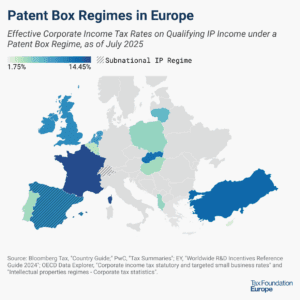
The EU’s Questionable VAT Policy
7 min readBy:According to the latest “VAT Gap” report published by the European Commission, value-added taxA tax is a mandatory payment or charge collected by local, state, and national governments from individuals or businesses to cover the costs of general government services, goods, and activities. (VAT) compliance decreased in 2022. The VAT compliance gap—the additional VAT revenue that could be collected if all taxpayers, consumers, and businesses fully complied with VAT rules—increased from 6.58 percent in 2021 (€76 billion) to 6.99 percent in 2022 (€89 billion).
In 2022, the largest compliance gaps were observed in Romania (30.6 percent), Malta (25.9 percent), Lithuania (14.6 percent), and Slovakia (14.6 percent). The smallest compliance gaps were registered in Hungary (2.3 percent) and Cyprus, Portugal, and Ireland (all below 2 percent).
EU VAT Compliance Gaps Increased in 2022
| 2022 VAT Compliance Gap (%) | Percentage Change in VAT Compliance Gap from 2021 | |
|---|---|---|
| Romania | 30.60% | -4.20% |
| Malta | 25.90% | 0.40% |
| Lithuania | 14.60% | -1.10% |
| Slovakia | 14.60% | 0.90% |
| Greece | 13.70% | -3.80% |
| Croatia | 12.00% | 1.10% |
| Belgium | 11.00% | 4.00% |
| Italy | 10.60% | -0.30% |
| Slovenia | 9.20% | 5.60% |
| Denmark | 8.60% | 4.10% |
| Poland | 8.40% | 2.80% |
| Netherlands | 7.90% | 2.60% |
| Bulgaria | 7.70% | 3.90% |
| France | 6.00% | 0.00% |
| Sweden | 5.50% | 0.20% |
| Finland | 5.20% | 2.30% |
| Latvia | 5.00% | -5.20% |
| Spain | 4.60% | 0.50% |
| Estonia | 4.40% | 2.90% |
| Germany | 4.30% | -0.10% |
| Czechia | 4.20% | -2.40% |
| Luxembourg | 3.70% | -3.70% |
| Austria | 3.00% | 0.40% |
| Hungary | 2.30% | -2.40% |
| Ireland | 1.60% | 2.60% |
| Portugal | 1.30% | -2.70% |
| Cyprus | -0.70% | -6.80% |
| EU-27 | 6.99% | 0.40% |
The VAT compliance gap increased in 15 EU countries, decreased in 11 countries, and didn’t change in France. To understand this average increase in the compliance gap, a more thorough analysis of the VAT compliance gap is needed.
The VAT compliance gap is caused not only by VAT avoidance or gaps in enforcement but also by unpaid VAT due to bankruptcies, insolvencies, or legal tax optimization.
Using Eurostat data on bankruptcies, we find a positive but low correlation of 0.02 between the increase in the number of bankruptcies and the decrease in compliance. Nevertheless, in three countries—Greece, France, and Hungary—where VAT compliance increased, a stark increase in bankruptcies was also observed. Therefore, for these countries, the VAT compliance gap might be revised upward in the 2025 release of the “VAT Gap” report. According to the Commission’s report, the overall decrease in compliance was due to the rise in the service sector, tourism arrivals, and bankruptcy declarations.
In the 2024 release of the “VAT Gap” report, the VAT compliance gap for the years 2020 and 2021 was also revised upward, by an average of 1 percentage point. As the report now notes, this was “due to the somewhat inconsistent treatment of deferrals, and the lower quality of national statistics owing to the turbulent conditions in these years.” As we highlighted in last year’s post, in many countries, 2020 VAT payments were pushed into the 2021 fiscal year. This postponement artificially increased VAT tax collection in 2021, while having no impact on the VAT tax liability, explaining the artificial increase in VAT compliance in 2021. While the VAT gap was revised upward by one percentage point on average, for countries like Luxembourg, the Netherlands, or Croatia, the VAT gap was revised upward by more than 5 percentage points.
The VAT compliance gap will likely continue to increase in the coming years. The report estimates for 2023 show that the VAT compliance gap in absolute terms is expected to increase in 15 of the 17 countries for which estimates were available. Additionally, 2023 bankruptcy data already published by Eurostat portrays a gloomy perspective on businesses operating in the EU, as bankruptcies increased in 15 EU countries between 2022 and 2023. The biggest increases in bankruptcies were observed in Hungary (155 percent), Greece (110 percent), Malta (73 percent), the Netherlands (54 percent), and Estonia (52 percent).
While the European Commission focuses on improving VAT compliance, policy is a major contributor to VAT revenue losses. The VAT actionable policy gap—the additional VAT revenue that could realistically be collected by eliminating reduced rates and certain exemptions—is 19 percent, more than double the compliance gap.
The VAT policy gap is made up of two components: the rate gap and the exemption gap. The former represents lost VAT revenue due to reduced VAT rates, while the latter represents lost VAT revenue due to certain goods and services being exempt from the VAT. Policymakers often justify exemptions and reduced rates with arguments that they promote the consumption of certain goods and services to address equity, environmental, and other policy goals. But exemptions and reduced rates are bad policy because they distort consumption, inefficiently deliver fiscal benefits, add complexity for businesses, and reduce revenue, forcing governments to rely on less economically efficient revenue sources.
However, there are some services—namely, imputed rents, the provision of public goods, and financial services—that are VAT-exempt because it would be difficult to levy VAT on them. Subtracting the amount of lost VAT revenue caused by these services from the general policy gap leaves us with the actionable policy gap (i.e., the actionable exemption gap plus the rate gap), which is the amount of additional VAT revenue lawmakers could realistically raise by eliminating reduced rates and certain exemptions.
In 2022, the average actionable policy gap for the EU was 19 percent—of which 12 percent was due to reduced rates (rate gap) and 7 percent to the actionable portion of the exemption gap.
The rate gap is smaller in countries that rely on reduced rates less, such as Denmark (0.6 percent), Estonia (2.6 percent), Bulgaria (4.2 percent), Lithuania (4.5 percent), and Latvia (4.8 percent). However, the rate gap in Poland (22.7 percent), Cyprus (19.8 percent), Luxembourg (18.9 percent), Greece (18.6 percent), Austria (17.6 percent), Italy (16.3 percent), Portugal (16 percent), Spain (15.8 percent), and Malta (15.7 percent) show significant revenue forgone because of reduced rates. The highest actionable exemption gaps are observed in Spain (13.5 percent), Poland (10.7 percent), Slovenia (9.9 percent), Italy (9.9 percent), Greece (9.8 percent), and Slovakia (9.2 percent).
The highest actionable policy gaps are observed in Poland (33.4 percent), Spain (29.3 percent), Greece (28.4 percent), Italy (26.2 percent), Portugal (22.2 percent), Cyprus (21.9 percent), Luxembourg (21.3 percent), and Slovenia (21.1 percent). Spain’s actionable policy gap is due in part to the application of different indirect taxes in the Canary Islands, Ceuta, and Melilla. The actionable policy gap is smaller in Malta (2.4 percent), Denmark (2.8 percent), and Bulgaria (5.5 percent).
Between 2021 and 2022, the VAT actionable policy gap increased from 17.6 percent to 19 percent. The average actionable policy gap for the EU increased by 1.4 percentage points, of which 1.1 percentage points were due to the increase in the rate gap and 0.3 percentage points were due to the increase in the actionable exemption gap. However, this trend will likely change in 2023 and 2024, as the temporary rate reductions to VAT on energy and food products, as a price support measure to cushion the impact of a sharp rise in energy prices and inflationInflation is when the general price of goods and services increases across the economy, reducing the purchasing power of a currency and the value of certain assets. The same paycheck covers less goods, services, and bills. It is sometimes referred to as a “hidden tax,” as it leaves taxpayers less well-off due to higher costs and “bracket creep,” while increasing the government’s spending power. , expire. If no new rate reductions are introduced, the VAT base will broaden, decreasing the VAT rate gap and consequently the actionable policy gap in 2023 and 2024.
As the compliance gap is expected to increase in the following years, policymakers will need to closely monitor both compliance and rate gaps. In a recent survey regarding companies’ barriers to conducting business in the EU single market, VAT ranked first, at 17 percent. Therefore, policymakers should invest in reforming VAT systems to close both compliance and policy gaps in ways that improve the overall efficiency of their tax systems.
Share this article




